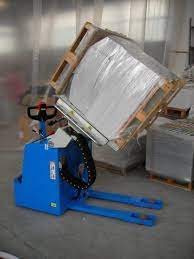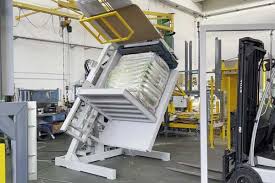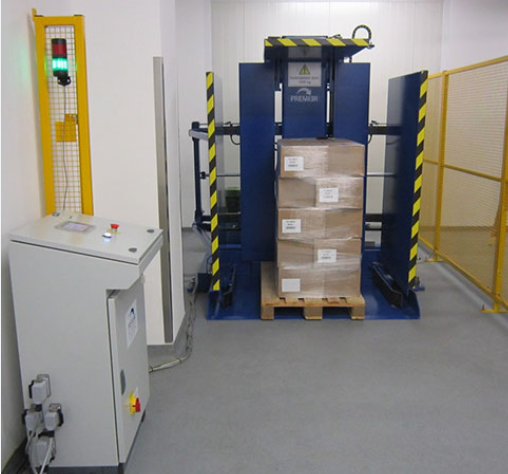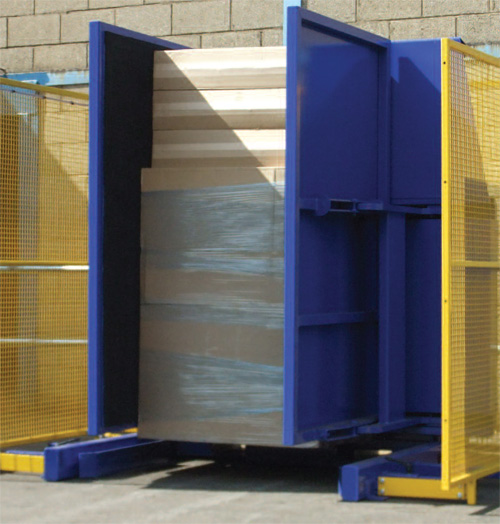Cutting Downtime in United States: How Pallet Changing Machines Help
Every minute your production line is stopped, money drains from your business. In the fast-paced logistics and manufacturing environments across the United States, these delays are more than just minor frustrations. They are critical bottlenecks. You might see workers struggling to manually transfer goods from one pallet to another, a slow and risky process. This single, manual step can halt an entire automated system, causing backlogs, missed shipping deadlines, and mounting pressure on your team. What if you could eliminate this bottleneck completely? Imagine swapping entire pallet loads in seconds, without the risk of manual labor. This is the solution that pallet changing machines bring to the factory floor.
Pallet changing machines help cut downtime in United States facilities by automating the transfer of goods between pallets. This process eliminates slow and risky manual handling, reduces the chance of product damage, and accelerates overall logistic operations. By integrating into production lines, they create a seamless flow, significantly boosting operational uptime and overall plant efficiency.

The core benefit is clear: speed and automation. But the impact of this technology goes much deeper than just a faster pallet swap. It affects your operational efficiency, your team's safety, and your bottom line in ways that are crucial for any manager or owner to understand. As an engineer and factory owner myself, I've seen firsthand how the right piece of equipment can transform an entire operation. So let's dive deeper into the specific ways these machines help you win back valuable production time.
How Do Pallet Changers Directly Boost Operational Efficiency?
Your production line runs like a well-oiled machine, but then everything stops at the final stage. A pallet is damaged, or you need to switch from your in-house wooden pallets to plastic ones for a specific client. Everything grinds to a halt. This common scenario creates a frustrating bottleneck that ripples backward through your entire process, wasting time and stressing your team. A pallet changer solves this problem by turning a manual, time-consuming task into a quick, automated step, keeping your products moving without interruption.
Pallet changers boost operational efficiency by replacing the slow, labor-intensive process of manual pallet swaps with a rapid, automated cycle. This simple change allows for a continuous flow of materials, which reduces production cycle times. It also frees up your skilled employees to focus on more complex, value-added tasks instead of simple manual labor. This directly increases the total throughput of your facility.

From Manual to Automated: A Clear Difference
The most direct impact on efficiency is the time saved. A manual pallet exchange can take two workers anywhere from 10 to 30 minutes, depending on the load's weight, stability, and complexity. The process is physically demanding and prone to errors. An automated pallet changer, however, can perform the same task in about 60 to 90 seconds with a single operator overseeing the process.
Let's look at a simple comparison.
| Metric | Manual Pallet Change | Automated Pallet Changer |
|---|---|---|
| Time per Pallet | 15 minutes (average) | 1.5 minutes (average) |
| Personnel Required | 2 workers | 1 operator |
| Risk of Product Damage | High | Very Low |
| Consistency | Varies | Highly Consistent |
| Physical Strain | High | Negligible |
The numbers speak for themselves. In a facility that handles 50 pallets a day, a manual process consumes over 12 hours of labor. An automated system does it in just over an hour. This reclaimed time goes directly back into productive activities, increasing your plant's capacity without adding staff.
Reducing Product Damage and Waste
Every time a product is dropped, tipped over, or damaged during a manual transfer, it represents a direct loss. The cost of the damaged goods is just the beginning. You also lose the time and resources invested in producing it, and the downtime required for cleanup further disrupts operations. Pallet changers handle loads with smooth, controlled movements. They clamp the load securely before tilting or pushing it, ensuring that even unstable products are transferred safely. I once worked with a beverage company in the US that was losing thousands of dollars a month from broken bottles during manual restacking. After installing a pallet inverter, their product damage from pallet swapping dropped to nearly zero in the first quarter. This not only saved them money on lost product but also reduced cleanup downtime.
How Do Pallet Changers Integrate With Modern Warehouse Automation Systems?
You have invested heavily in creating a modern, automated facility. You have Automated Guided Vehicles (AGVs) moving goods and a sophisticated Warehouse Management System (WMS) directing traffic. But there is a gap. When a pallet needs to be changed, the automated process stops, and a manual task begins. This gap breaks the chain of automation. It requires human intervention, slows down the entire system, and prevents you from realizing the full benefits of your investment. Modern pallet changers are designed to be the missing link, integrating perfectly with your other systems to create a truly automated, "lights-out" operation.
Pallet changers integrate with modern automation systems like AGVs and conveyors using PLCs and intelligent sensors. They can receive commands directly from a central WMS to perform a pallet swap automatically. This makes the pallet changer a key functional node in a fully connected logistics system. It becomes another smart device on your network, contributing to a seamless and data-rich environment.

The Technical Connection: PLC and WMS
At the heart of this integration is the pallet changer's Programmable Logic Controller (PLC). The PLC is the machine's brain. It can communicate with your facility's WMS through standard industrial protocols like Ethernet/IP or PROFINET. Here is how a typical automated sequence works:
- Your WMS identifies a pallet that needs to be swapped. It could be an incoming pallet that is not compatible with your racking or an outbound load that needs to be on a shipping pallet.
- The WMS dispatches an AGV to pick up the pallet and deliver it to the pallet changer's infeed conveyor.
- Sensors on the conveyor confirm the pallet has arrived, and the PLC signals the WMS.
- The WMS gives the command to start the change cycle. The PLC executes the transfer, moving the goods to a new pallet dispensed from an integrated stacker.
- Once the cycle is complete, the PLC informs the WMS. The WMS then directs another AGV to retrieve the newly palletized load.
This entire process happens without a single person touching the product. It’s fast, efficient, and error-free.
Data for Predictive Maintenance
Integration is not just about commands; it's also about data. Modern pallet changers are equipped with IoT sensors that monitor their own health. They can track motor amperage, hydraulic pressure, cycle counts, and operating temperatures. This data is sent back to your central control system. By analyzing these trends, you can implement a predictive maintenance schedule. For example, your system might flag a slight increase in motor current, suggesting a bearing is starting to wear out. You can then schedule maintenance during a planned shutdown, rather than waiting for an unexpected and costly failure. This aligns perfectly with the goal of achieving 95% or higher equipment uptime. It transforms maintenance from a reactive chore to a proactive strategy.
Can Pallet Changers Improve Workplace Safety and Reduce Related Downtime?
An employee is out on leave with a back injury. The cause was trying to manually restack a heavy load from a broken pallet. This is more than just an unfortunate event; it is a significant business disruption. You are now facing potential workers' compensation claims, lost productivity from an experienced team member, and the challenge of training a replacement. This hidden downtime is a major cost. Pallet changers directly address this by eliminating the root cause of these injuries, creating a safer work environment and preventing these expensive incidents.
Yes, pallet changers dramatically improve workplace safety. They do this by removing the need for employees to manually lift, bend, and restack heavy or awkward loads. This single change drastically reduces the risk of musculoskeletal injuries, such as back strains and shoulder injuries. These types of injuries are a leading cause of lost workdays and downtime in industrial and logistics settings across the United States.

The High Cost of Manual Handling Injuries
Injuries from overexertion, which includes lifting, pushing, and pulling, are consistently one of the top causes of workplace injuries in the US that lead to time away from work. The costs are enormous. Direct costs include medical bills and compensation payments. But the indirect costs are often much higher. These include:
- Lost Productivity: The injured worker is absent, and the team is less efficient.
- Administrative Time: Managers and HR staff must handle incident reports and claims.
- Replacement Costs: Overtime for other workers or hiring and training temporary staff.
- Lower Morale: Accidents can negatively impact the morale and confidence of the entire team.
By designing the physical risk out of the task, a pallet changer is a powerful engineering control that protects your most valuable asset: your people.
Ergonomics by Design
Let's compare the physical demands of the task.
| Ergonomic Risk Factor | Manual Pallet Change | Automated Pallet Changer |
|---|---|---|
| Heavy Lifting | Constant, often over 50 lbs | Eliminated |
| Awkward Postures | Bending, twisting, reaching | Eliminated |
| Repetitive Motions | High, for each box/bag | Eliminated |
| Risk of Falling Objects | Present | Contained within machine |
A pallet changer does all the strenuous work. The machine takes on the burden of lifting loads that can weigh over a ton. It performs the tilting and turning motions that would place immense strain on a human spine. The operator's job shifts from manual laborer to skilled supervisor, a role that is safer, more engaging, and less physically taxing. I remember a client in the steel industry who was struggling with high employee turnover in their shipping department. The work was just too hard. After they installed two pallet inverters, their turnover rate in that department fell by over 50% in one year. They kept their experienced people, which in turn made the whole department run more smoothly.
What Is the Real Return on Investment for a Pallet Changer in a US Facility?
You understand the operational and safety benefits of a pallet changer, but the upfront cost of new machinery can seem high on a proposal. It is natural to look at that number and feel hesitant. But delaying the decision has its own cost. Every day you continue with an inefficient, unsafe manual process, you are losing money to the very problems the machine is designed to solve. The cost of inaction is real and accumulates over time. A pallet changer is not an expense. It is a strategic investment with a clear, measurable, and often surprisingly fast return.
The real return on investment (ROI) for a pallet changer is calculated by combining all the financial benefits and comparing them to the initial cost. These benefits include direct savings from reduced labor, the elimination of product damage costs, increased revenue from higher throughput, and lower expenses related to workplace injuries. For many industrial facilities in the United States, the payback period for this investment can be as short as 12 to 24 months.

Calculating Your Direct Savings
The easiest place to start is with labor. Let's use a conservative example. Assume a manual pallet swap takes two workers 15 minutes, and your fully burdened labor rate is $25/hour per worker. An automated changer takes one operator 2 minutes.
- Manual Cost per Pallet: 2 workers 0.25 hours $25/hour = $12.50
- Automated Cost per Pallet: 1 operator 0.033 hours $25/hour = $0.83
- Savings per Pallet: $11.67
If your facility handles 40 pallets per day for 250 days a year, the annual labor savings alone would be:
$11.67/pallet 40 pallets/day 250 days/year = $116,700 per year.
This single calculation often justifies the investment on its own.
The Hidden Costs You Eliminate
Beyond labor, an ROI calculation must include the other costs that a pallet changer reduces or completely eliminates.
| Cost Category | Manual Process Cost (Annual Estimate) | Automated Process Cost |
|---|---|---|
| Product Damage | $15,000 (e.g., 0.5% of handled goods value) | < $1,000 |
| Workplace Injury | $40,000 (cost of one average claim) | Risk drastically reduced |
| Pallet Costs | $5,000 (damage to pallets, rental fees) | Reduced damage, better management |
| Downtime Costs | $20,000 (production halts for cleanup/swaps) | Minimal |
When you add these avoided costs to your labor savings, the financial picture becomes even more compelling.
From Cost Center to Profit Center
The ultimate goal of any investment is not just to save money, but to make money. This is where increased throughput comes in. By removing a major bottleneck, the pallet changer allows your entire production line to operate at a higher capacity. If you can ship just 5% more product because your logistics are faster and more reliable, that translates directly to increased revenue and profit. For a business with millions in revenue, a 5% increase is a massive win. It transforms the pallet changer from a piece of cost-saving equipment into an engine for growth.
My Insights
When I started my journey in this industry, I was an engineer on the factory floor. I saw the daily struggles with inefficient equipment and the constant pressure to get products out the door. Later, when I built my own factory, I sat on the other side of the desk. I was the one who had to look at the numbers, just like you. I had to scrutinize every investment and make sure it would pay for itself. I understand the weight of that decision.
What I learned over all those years is that a machine is never just a machine. It is a solution to a problem. A pallet changer isn't just a ton of steel and hydraulics; it's the answer to downtime, to safety risks, and to production bottlenecks. The best suppliers know this. They aren't just selling you a product; they are offering a partnership. They should understand your challenges—whether it's aging equipment, pressure to digitize, or the need to improve profit margins—and provide a solution that addresses those specific needs.
That is why I started SHJLPACK as a knowledge-sharing platform. I was fortunate that this industry allowed me to achieve my goals. Now, I want to give back by sharing what I've learned. I believe that by helping others understand the 'why' behind the technology, we can all build stronger, safer, and more profitable businesses. When you invest in the right solution, you are not just cutting downtime; you are building a more resilient future for your company.
Conclusion
Pallet changers are a powerful tool. They cut downtime, improve safety, and deliver a strong ROI. They are a strategic investment in your facility's future.



